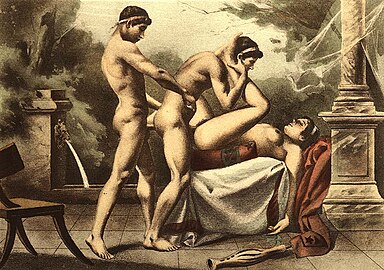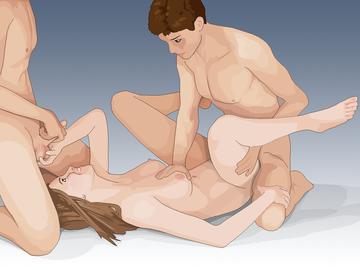| Revision as of 14:54, 9 June 2021 editTrappist the monk (talk | contribs)Administrators479,773 editsm cite repair;← Previous edit | Revision as of 01:11, 10 June 2021 edit undoGiraffedata (talk | contribs)Extended confirmed users, Pending changes reviewers98,788 edits comprised ofNext edit → | ||
| Line 18: | Line 18: | ||
| == Academic research on threesomes == | == Academic research on threesomes == | ||
| The first major academic work to address threesomes specifically was published in 1988, called: ''Threesomes: Studies in Sex, Power, and Intimacy''<ref>{{Cite book|last=Karlen|first=Arno |title=Threesomes : studies in sex, power, and intimacy|date=1988|isbn=0-688-06536-8|location=New York|oclc=17104896}}</ref> by ] In the work, drawing mainly from interview data, Karlen outlined how threesomes were often viewed as qualitatively different to other forms of group sex. Other notable findings include that threesomes were often viewed by women as a safe way to explore their sexuality; they often |
The first major academic work to address threesomes specifically was published in 1988, called: ''Threesomes: Studies in Sex, Power, and Intimacy''<ref>{{Cite book|last=Karlen|first=Arno |title=Threesomes : studies in sex, power, and intimacy|date=1988|isbn=0-688-06536-8|location=New York|oclc=17104896}}</ref> by ] In the work, drawing mainly from interview data, Karlen outlined how threesomes were often viewed as qualitatively different to other forms of group sex. Other notable findings include that threesomes were often viewed by women as a safe way to explore their sexuality; they often consisted of a couple joined by a third person; and that the third person was not necessarily viewed or treated equally. Karlen also suggested that the societal view of threesomes cast those who engaged in them as radically different to other members of society:<blockquote>''There is a common tendency to think of people who have been in threesomes as alien beings. Like swingers, homosexuals and others who deviate from basic sexual norms, they seem to many to have entered another social, psychological, and moral sphere.''</blockquote> | ||
| == Sex positions == | == Sex positions == | ||
Revision as of 01:11, 10 June 2021
This article is about sexual activities involving three people. For other uses, see Threesome (disambiguation). "Three-way" redirects here. For other uses, see 3-way (disambiguation).Sexual activity that involves three people at the same time
| This article needs additional citations for verification. Please help improve this article by adding citations to reliable sources. Unsourced material may be challenged and removed. Find sources: "Threesome" – news · newspapers · books · scholar · JSTOR (February 2019) (Learn how and when to remove this message) |

In human sexuality, a threesome is commonly understood as "a sexual interaction between three people whereby at least one engages in physical sexual behaviour with both the other individuals". Though threesome most commonly refers to sexual activity involving three participants, it is also sometimes used to apply to a long-term domestic relationship, such as polyamory or a ménage à trois.
A threesome is a form of group sex which may occur in private situations, such as spontaneous sexual activity among three friends or in the context of casual sex or a hook up. Alternatively, it may take place in specific contexts or environments which allow for sex, such as swingers events, orgies or sex parties.
A threesome is a common element of sexual fantasy, and it is commonly depicted in pornography.
Types
The people in a threesome may be of any gender and sexual orientation. Each participant may engage in any type of sex act with one or both of the others, such as vaginal, anal or oral sex or mutual masturbation. One or more of the participants may engage in autoerotic sexual activity, such as masturbation, possibly without physical contact with the other participants. It is a matter of subjective definition whether participation of a third person without physical contact constitutes a threesome. This may relate to fetishes such as voyeurism or cuckolding. Lucky Pierre is slang for a person performing both receptive and insertive anal and/or vaginal sex simultaneously during a threesome, being positioned between the two partners.
A heterosexual threesome may involve two men and a woman, for example, in double penetration, or two women and a man. A bisexual threesome may involve a man having sex with a man and a woman, the woman having sex with a man and a woman, or all three having sex with each other. A homosexual threesome would involve either three men or three women. Other possibilities are possible, such as a man having sex with two women who are having sex with each other.
Academic research on threesomes
The first major academic work to address threesomes specifically was published in 1988, called: Threesomes: Studies in Sex, Power, and Intimacy by Arno Karlen. In the work, drawing mainly from interview data, Karlen outlined how threesomes were often viewed as qualitatively different to other forms of group sex. Other notable findings include that threesomes were often viewed by women as a safe way to explore their sexuality; they often consisted of a couple joined by a third person; and that the third person was not necessarily viewed or treated equally. Karlen also suggested that the societal view of threesomes cast those who engaged in them as radically different to other members of society:
There is a common tendency to think of people who have been in threesomes as alien beings. Like swingers, homosexuals and others who deviate from basic sexual norms, they seem to many to have entered another social, psychological, and moral sphere.
Sex positions
Threesome sexual activity may take place in a number of sex positions; for example, the following:
-
 Painting by Édouard-Henri Avril: threesome involving two men and a woman
Painting by Édouard-Henri Avril: threesome involving two men and a woman
-
 Threesome involving double penetration
Threesome involving double penetration
-
 Threesome involving two men and a woman
Threesome involving two men and a woman
-
 Threesome involving two women and a man
Threesome involving two women and a man
Media
Threesome scenes are featured in various films and TV series, including Summer Lovers (1982), Threesome (1994), Wild Things (1998), American Psycho (2000), Zoolander (2001), Y Tu Mamá También (2001), Ken Park (2002), The Dreamers (2003), Vicky Cristina Barcelona (2008), Shame (2011), On the Road (2012), Savages (2012), Spring Breakers (2012), Knock Knock (2015), Love (2015),You Me Her (2016–2020) and Holly Slept Over (2020).
See also
References
- ^ Scoats, Ryan (2019). UNDERSTANDING THREESOMES: gender, sex, and consensual non-monogamy. ROUTLEDGE. ISBN 978-0-429-84237-5. OCLC 1110711748.
- Thompson, Ashley E.; Byers, E. Sandra (April 2017). "Heterosexual Young Adults' Interest, Attitudes, and Experiences Related to Mixed-Gender, Multi-Person Sex". Archives of Sexual Behavior. 46 (3): 813–822. doi:10.1007/s10508-016-0699-1. ISSN 0004-0002.
- Scoats, Ryan; Joseph, Lauren J; Anderson, Eric (February 2018). "'I don't mind watching him cum': Heterosexual men, threesomes, and the erosion of the one-time rule of homosexuality". Sexualities. 21 (1–2): 30–48. doi:10.1177/1363460716678562. ISSN 1363-4607.
- Suzanne G. Frayser; Thomas J. Whitby (1995). Studies in Human Sexuality: A Selected Guide. Libraries Unlimited. pp. 340–341. ISBN 1563081318. Retrieved October 3, 2013.
- LEHMILLER, JUSTIN J. (2018). TELL ME WHAT YOU WANT: The Science of Sexual Desire and How It Can Help You Improve Your Sex Life. ROBINSON. ISBN 1-4721-4223-3. OCLC 1013584575.
- Jonason, Peter K.; Marks, Michael J. (March 2009). "Common vs. Uncommon Sexual Acts: Evidence for the Sexual Double Standard". Sex Roles. 60 (5–6): 357–365. doi:10.1007/s11199-008-9542-z. ISSN 0360-0025.
- Claire Maniez (2012). Science and American Literature in the 20th and 21st Centuries: From Henry Adams to John Adams. Cambridge Scholars Publishing. p. 164. ISBN 1443835196.
- Shere Hite, The Hite Report: The sexual experience of women, Munich, 1989
- Karlen, Arno (1988). Threesomes : studies in sex, power, and intimacy. New York. ISBN 0-688-06536-8. OCLC 17104896.
{{cite book}}: CS1 maint: location missing publisher (link) - American Psycho threesome scene. Retrieved 2015-10-24.
- Hoarde, Peter. "The 10 Most Memorable Threesome Scenes in Movies". Complex.com. Retrieved 29 September 2018.
External links
![]() Media related to Threesome at Wikimedia Commons
Media related to Threesome at Wikimedia Commons
| Sex positions | |
|---|---|